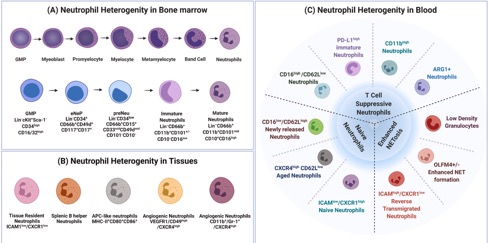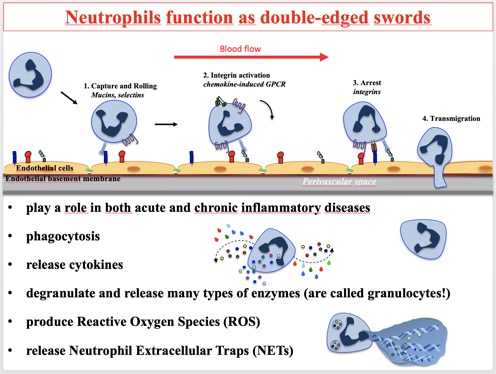
Neutrophils are the most represented immune cell in human blood, where they patrol and protect the host from pathogens and other harmful agents.
The classical view for these leukocytes is that neutrophils constitute a homogenous population of terminally differentiated cells with a unique function. However, evidence accumulated in recent years has revealed that neutrophils present a considerable phenotypic heterogeneity and functional versatility, which place neutrophils as essential modulators of both inflammation and immune responses.

During acute inflammation, neutrophils can perform a variety of effector mechanisms playing a beneficial role to the host. In the context of an inflammatory response, neutrophils are inherently helpful; it is only when their responses become excessive or unregulated that injury to host tissues may ensue.
However, when the injury generates the inflammatory process, also known as sterile inflammation, the beneficial contribution of neutrophils to tissue repair becomes more controversial. The immune system and its components are designed to be protective, but there is also a capacity for harm. In fact, in several pathological conditions, including cancer and autoimmunity, neutrophils are also harmful to the host leading to tissue damage.
This damage may occur through several independent mechanisms:
(i) premature activation during migration,
(ii) extracellular release of toxic products during the killing of some microbes, removal of infected or damaged host cells and debris as the first step in tissue remodeling,
(iii) or failure to terminate acute inflammatory responses.

Neutrophils are highly responsive cells releasing reactive oxygen species (ROS), enzymes (myeloperoxidase and neutrophil elastase, to name but a few), neutrophil extracellular traps (NETs), and cytokines, and can thus cause unintended damage to endothelial cells and surrounding tissues, often resulting in pathological conditions, even in the absence of substantial accumulation within tissues.
Neutrophils have been recognized as critical players in neuro-inflammatory disorders, ranging from bacterial and viral encephalitis to non-infectious conditions, such as cerebral ischemia, trauma, and demyelinating syndromes.
Previous studies have shown that neutrophils transmigrated in the central nervous system acquire a toxic phenotype and approach neuronal cells, where they release harmful molecules and can compromise neuronal functions. Therefore, limiting neutrophil migration and functions can positively influence the outcome of neuronal injuries.
Neutrophils can walk a fine line between being critical players in immunological defenses while also having detrimental contributions to pathological conditions.
This dual nature in contributions to health and disease insinuates a potential to manipulate neutrophil phenotypes via immunotherapeutic tools to obtain desired outcomes.